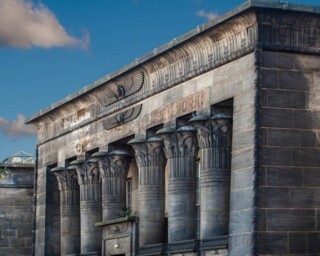Grass on the Roof
Gillian Darley
Victorian industrialists had a particular approach to advertising and branding, with money no object. Where feasible, the factory or mill itself was designed to promote the product. Rather like stained glass windows in medieval churches, easily instructive for the illiterate, the buildings were set free to tell the story. The façade of John Marshall’s linen mill at Holbeck in Leeds, built in the late 1830s, was a magnificent copy of the great temple at Edfu: flax had been cultivated in Egypt, and linen woven from it, since ancient times.
To build the new mill, the company engineer James Combe turned to an expert. Joseph Bonomi the Younger was far better known as an Egyptologist than as an architect (this would be his only building). Between them, Combe and Bonomi came up with a visionary kind of textile works. The two-acre weaving shed was top-lit with conical, vented, rooflights – they looked, people thought, rather like cucumber frames. John Soane had used this arrangement, on a smaller scale, over rooms in his house at Lincoln’s Inn Fields (Bonomi later became curator of the house-museum from 1861 until his death).
To help maintain the right temperature and humidity for flax weaving inside the mill, grass was grown on the roof. A hydraulic lift carried sheep up to graze there, until disaster struck and an animal crashed down on the looms below. Rainwater was channelled down inside the hollow iron columns and used to produce steam. The mill’s credentials were very green indeed.
Edfu still stands on the west bank of the Nile; a new visitor centre was built in 2005. Temple Works has had a rougher ride. Used after the Second World War as a Kays mail order catalogue depot, it later fell into the indifferent ownership of the Barclay brothers. Pressured to safeguard it, but deaf to all pleas, they eventually sold it for £1 in late 2017, by which time it was seriously dilapidated and at great risk of collapse. The buyers were CEG, a local property firm that has already spent a considerable amount on essential work and is supported energetically by the campaigning conservation body SAVE Britain’s Heritage, who have called on specialist engineers for emergency works and reassurance.
Now it appears – a tiny wisp of white smoke against black skies – as if Temple Works may become the headquarters of the British Library in the north. One Victorian novelist at least would be letting off celebratory fireworks. Benjamin Disraeli wove the building into Sybil (1845), the mill owner Mr Trafford bearing considerable resemblance to Mr Marshall. His works, described in detail, was ‘one of the marvels of the district; one might almost say of the country’.

Comments
Best wishes!
David.
"To help maintain the right temperature and humidity for flax weaving inside the mill, grass was grown on the roof. A hydraulic lift carried sheep up to graze there, until disaster struck and an animal crashed down on the looms below. Rainwater was channelled down inside the hollow iron columns and used to produce steam. The mill’s credentials were very green indeed."
Must be the coronavirus that makes me so in need of soothing. But these words did it!